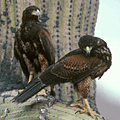"Evolutionary genetics" is a somewhat redundant expression. After all,
Charles Darwin understood that natural selection required an inheritance
mechanism, although it took nearly a century to reconcile his ideas
with those of classical genetics. Moreover, much of the reconciliation
between Mendelian genetics and Darwinian evolution involved advances in population and quantitative genetics.
These articles here can be
arbitrarily divided into five main categories: phylogenetics; mutation
and molecular population genetics; the genetics of speciation; genome
evolution; and evolution and development (also known as evo-devo).
In the area of phylogenetics, David Baum has contributed a pair of articles on "tree-thinking"; the first describes how to read a phylogenetic tree, while the second discusses the implications of such trees with regard to relatedness and the myth of evolutionary advancement.
Next, to introduce molecular population genetics, Laurence Loewe discusses mutation in the context of molecular evolution, and Laurent Duret elaborates on that topic in his article on neutral mutations. Natural selection is then introduced in a pair of articles. Here, Laurence Loewe explains negative selection
(i.e., selection against harmful mutations), while Stephen Schaffner
and Pardis Sabeti explain positive selection (i.e., selection for
beneficial mutations). Sabeti also contributes an article on the impact of positive selection in humans. To round out this portion article collection, Sally Otto discusses the evolutionary advantage of sex, while Simon Ho explores the concept of the molecular clock.
We then turns toward the subject of speciation. Norman Johnson begins by discussing genic models of speciation,
specifically the role of epistasis in the Dobzhansky-Muller model.
Johnson also describes researchers' current understanding of Haldane's rule,
which states that sterility and inviability tend to be associated with
the heterogametic sex in species hybrids. Laurie Stevison next examines
the relevance of gene flow between incipient or recently diverged species.
Finally,
with respect to genome evolution, Chitra Chandrasekaran and Esther
Betrán offer their discussion of the possible fates of duplicated genes, including the formation of pseudogenes.




